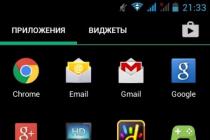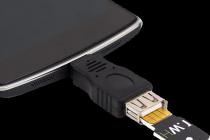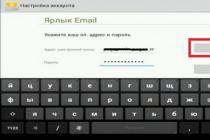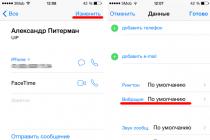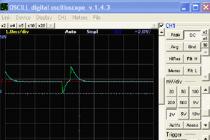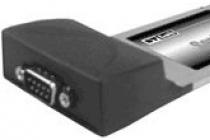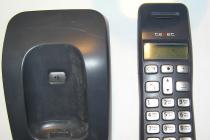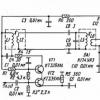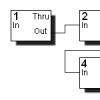Gadgets running Android OS have different advantages compared to other systems. You can list all of them for a long time, but you should stop at one of them. In particular, such devices support connecting various gadgets to them via a regular USB interface. But this requires an "intermediary", which is an OTG cable. What is it and how to use it? You will learn all this from this article.
OTG cable - what is it?
This cable is very short, with a regular USB connector on one end and a MicroUSB plug on the other. As you already understood, the MicroUSB plug is inserted into the smartphone, and you can already connect anything.
Let's see what can be connected to the phone via an OTG cable. What is it, we have already figured it out, now another question - what is it for?
We connect the USB flash drive
Connecting a flash drive is the easiest way to use an OTG cable. What does it give? At least from the phone you can listen to music that is recorded on a regular flash drive. You can also watch movies from a flash drive. If your phone does not have enough memory for a movie, then burn it to a flash drive and watch it on your gadget via an OTG cable.

It is worth noting that in most cases it is possible to connect a USB flash drive through this cable, but there may be problems. It all depends on the firmware that is installed on the phone. For example, it is so difficult to set up an OTG cable that it involves installing third-party programs. You can also solve this problem by installing custom firmware, but you will have to tinker anyway.
card reader
If the phone recognizes a USB flash drive, then it will most likely be able to recognize a card reader with an SD card inside. In most cases, the phone sees a memory card inserted into the card reader. Thus, on a smartphone, you can edit the contents of SD cards using an OTG cable. That it can be useful in any situation is, perhaps, obvious.

External hard drive
A disk with a memory of 500-700 GB can also be connected to the phone. So far, smartphones cannot have such an amount of memory, but with an external drive, it is. And all you need is a short OTG cable. What will it give the user? As in the case of a flash drive, it will be possible to watch full-fledged films even in FullHD quality on the phone. A smartphone would probably not have enough memory for large tapes, but it will definitely be enough on a disk.
However, there are often errors when connecting a hard drive via USB OTG. That this happens is known to many users. Therefore, there is even an application USB OTG Helper, which itself finds the connected drive and mounts it. After connecting, it becomes available in the file manager. But even this program does not always save. For example, a Seagate 4 GB hard drive does not show up at all even with this program. It is quite possible that the disk simply does not have enough smartphone power.
Mouse
Surprisingly, if you connect a mouse to your smartphone through this cable, then a cursor will appear on the screen, and it will respond to all mouse movements. Just like on a computer, all programs and icons will be opened by double-clicking. Of course, there is no practical benefit from using a mouse on a smartphone, but just for the sake of experiment, it's worth a try. Does anyone else doubt that USB OTG is cool?

Keyboard
Contrary to popular belief that tablets and phones were designed to consume content, not create content, it is possible to type text on a tablet or smartphone using the keyboard. It connects via an OTG cable, and any Android device recognizes it perfectly. Now text writing is much more convenient, because the virtual keyboard is complete nonsense, which is suitable for social networks, but not for writing texts.
Gamepad
There are specialized solutions for playing on smartphones, but you can connect a full-fledged game controller via a cable. Can you play with it? Quite! On Android devices, even a gamepad can be connected.
USB hub
By connecting a USB hub, you can create a workstation with a mouse and keyboard from your phone. In addition, you can connect speakers. True, there are no guarantees that all connected devices will fully work, although it’s worth a try.

Other
Most modern speakers plug into a computer's USB port for power and into a 3.5mm jack. At the same time, the speakers from the mobile USB port have enough power. Also, many cool headphones are not connected via a "minijack", but directly via USB. It's a shame when cool "ears" can not be used in conjunction with a smartphone. But with an OTG cable, this becomes possible.
Connecting a printer is a really useful thing, for which it is worth having such a cable. It is very convenient to print documents that are stored on a smartphone on the printer. But even more convenient to print photos. Of course, it is better that the printer is connected to a Wi-Fi network, but if it does not have such functionality, then you can completely get by with an OTG cable. What is it, you now know.
Another option that is suitable for tablets without 3G / 4G modems. We are talking about connecting a modem that will provide access to the 3G / 4G network. Not all tablets have support for these standards, and if they do, then such models are more expensive. You can save some money if you buy a gadget modification without support for a third or fourth generation wireless network and use a USB modem that you accidentally lay around at home. With an OTG cable, this became possible, and the tablet recognizes it perfectly. But there is a caveat: you can connect a modem only with superuser rights and with the help of certain programs. In most cases, the PPP Widget 2 application helps.
You can continue to experiment for a long time, but the main thing is that you understand what this cable is.
The USB OTG cable is an interesting accessory that you might find useful when used with your tablet or . What prospects does it open up for us and what opportunities will become available when using it? And what does “OTG” even mean? These questions are often asked by users who hear about this kind of cable for the first time. Let's find out more about it.
How to use a USB OTG cable for your Android tablet or smartphone
In general, OTG is an abbreviation of On-The-Go, which means “on the go” in English. This is a USB 2.0 extension technology. With it, you can, flash cards, printers, keyboards, hard drives, cameras and other peripherals without connecting to the computer itself. The only condition is that your device must support this feature at the hardware and software level.
If you connect according to the USB OTG standard, the abilities of the master (power source) and slave (power consumer) gadgets are assigned by whether it has a jumper between the fourth and fifth pins in the cable connector for connection.
There is also partial support for USB-host devices on Android (mostly smartphones), when your gadget can control the device without powering it. Then the auxiliary electronics are connected using an active USB hub, which has its own power supply system. How can you use such a miracle cable?

Examples of using USB OTG cable
There are a huge number of ways to use a USB OTG cable. Let's look at the most popular of them.

But it happens that you don’t have such a cable now, and you don’t have the time or desire to look for the nearest mobile accessories store. Well, in this case, you can try to make such a cable yourself. Although this procedure is more intended for professional people.
Making a USB OTG cable with your own hands
Don't rush to rejoice so quickly, because you still have to go to the supermarket or radio store to get a whole list of different things!

First, using a sharp knife, you need to open the microUSB connector. The meaning of the action is to carefully divide the connector sleeve lengthwise into two equal parts in order to gain access to its internal contents. But it happens that the connector body is held on by simple latches or even glue. Then you will not have problems with separation. But in the first case, you need to be extremely careful: you cannot destroy the outer sleeve of the connector, since in the future it will still be used. You can also find white plastic inside that protects the necessary wires. In this case, you will need to cut through it.
Now you can move on to the next step. Having opened the connector contacts, you will find that their number is not four, but five. Basically the four pins are +5V power, two data wires D+ and D-, and ground. And the fifth wire, not connected to anything, is the mode switch input (sense). It must be connected to the ground before connecting to the device, in order for it to switch to OTG mode and detect a USB device connected to the interface. The image below shows the differences between regular cable and OTG.

So, to transfer the gadget to OTG mode, you need to close the fourth and fifth contacts. If you want to “deadly” connect them, you can solder them together or connect two wires to them (we bring these wires out and connect them to a microswitch, with which you can perform I / O operations in OTG mode if necessary). Then, on the opposite side of the cable, it is necessary to solder Type A Female (second type) in parallel with Type A Male (the first type of connector). In addition, you can build a small adapter with two Type A Females for its further connection to the opposite part of the cable. Having decided to connect the fourth and fifth contacts permanently, it is necessary to replace the first type connector on the opposite side with the second one so that it is suitable for connecting a USB device.
If you look at the specification of your mobile device, you can see a huge functionality that you might have never heard of before. For example, many users have never heard of OTG, and this technology is supported by most smartphones. What is it?
OTG (from the English On The Go - “on the go”) is a technology with which you can connect an additional device to your smartphone via a full-fledged USB port, so it’s correct to call the USB OTG function.
What can be connected to a smartphone using OTG? Many things, for example:
- Flash drive with information.
- External hard drive. True, in this case, the hard drive must have a separate power supply, otherwise it simply will not start.
- Mouse.
- Keyboard.
- Gamepad.
- Card reader.
- Columns.
- Webcam.
- A printer.
It is worth noting that most often users connect flash drives to their smartphones using OTG technology.
OTG cable
An OTG cable is used to connect the device to a smartphone. It is sold literally in every electronics store and not only, so there should be no problems with buying a cable.
The cable looks like this (in the example, from Olaudem):

There is also a cable for USB Type-C (in the example, from Aukey):

One side of the cable connects to a smartphone, the other side connects to an additional device.
There are also small adapters without a wire (in the example, from Vention):

If you need to connect several devices to your smartphone at the same time, you will need an OTG hub, which may look something like this:

The number of ports may vary.
Please note that in most cases no additional settings are required after connecting the device. If, for example, you connected a wired keyboard via OTG to your touch gadget, it should immediately work. Of course, if the smartphone supports OTG functionality. The same can be said about the mouse, card reader, speakers, etc. However, there are exceptions when you need to go into the settings, or even install third-party applications for the normal operation of the connected device.
How to know if a smartphone supports OTG?
As mentioned above, most smartphones and even tablets support OTG technology - in any case, this is what the device specification says. But in some cases this is not the case, so we recommend using the USB OTG Checker application just in case.

Install and run. You can immediately see on the screen whether OTG technology is supported on your device.

Is there another application - OTG? (That's right, with a question mark).

At startup, press the Check Now!

See the answer for OTG support. In our example, it is positive.

19.10.2016
Introduction
Hello! I decided to write an article so as not to answer the same questions. I thought about where to post it so that everyone could read it, and then I remembered Helpix. How long have I been here! Several years have passed since the last review. I went to the site and remembered my feelings of three years ago. For this one already Thank you! Although I still sometimes get comments on old posts and I come in to answer. Well, okay, back to the topic. In general, it turned out that I was often asked about USB OTG. It seemed to me that all users of smartphones and tablets know about it. But after being asked about 10 times in a few days, I thought that something had to be done. At first, I sent everyone to Google, but people are lazy now and want to hear about it from me. That's how I ended up here again.
What is USB OTG?
Let's start, what is USB OTG. Since I am also lazy and too lazy to type, I will quote, which I liked the ease of understanding.
"USB OTG (from English On-The-Go) is a USB function that is designed to easily connect USB devices to each other without the need for a computer. In practice, this means that two devices that support this function can be connected to each other. to a friend directly.For example, you have a camera and want to print photos.You do not need to connect it to a computer, you can connect it directly to a printer and print photos.However, in most cases everything is much simpler and OTG is usually used to connect a USB flash drive to a smartphone or tablet via USB - in this case, you can read data directly from the flash card. For example, you can start a movie on the screen of the device, which, in turn, was downloaded to the memory card. "
How it works?
An OTG cable is used for connection. There are two cables in the photo below. Both USB OTG. The only difference is that one was bought in DNS for 390 rubles. and is called "Ginzzu". The second one was bought from AliExpress. No Name for 18 rubles Film on the second cable for transportation, so as not to scratch! For 18 rubles! Same quality...
This is how the connected flash drive looks like:
You can also connect mice, keyboards, hard drives, etc. Hard drives require additional power from the mains. Also, for example, you can charge a smartphone from a tablet.
After the popularization of USB OTG, various "gadgets" began to appear. For example, a flash drive with an additional microUSB connector, OTG hubs, a fan for smartphones, etc. For example, I ordered a couple of adapters on AliExpress.
I love useful multifunctional things. For example, here is such an adapter. A microSD flash drive is inserted into it and can be used as a regular USB and at the same time an OTG flash drive.
Such an adapter costs about 50 rubles. When connected, it glows blue.
By the way, thanks to him, I realized that I have OTG on my tablet. My tablet is Prestigio Multipad Ranger 8.0 4G. It didn't have OTG support in the feature description. When checking through the cable, the flash drives were not connected either. But this confused me, since almost all tablets of this company support OTG and the cable comes with them. I remembered the first version of the Yoga Tablet, where in addition to WCDMA there was a GSM function, but due to the firmware it was not possible to use cellular communications. In general, when the adapter arrived and I connected it to the tablet, it caught fire, but the flash drive was not detected. I started to study the topic and found out that since there is power in USB, it will work. I installed various file managers to work with OTG. As a result, I installed the Nexus USB OTG File Manager, and the flash drive was determined. The strangest thing is that after that, ES Explorer also began to see her.
Now the file manager has been renamed and done
I am starting a series of reference articles on individual components and functions of various electronic devices - tablets, laptops, readers, players, and so on. This is such a kind of educational program in the field of consumer electronics. I will try to make these articles understandable to the widest possible range of people.
The topic of today's article is USB host (USB host). This is a very remarkable feature, which is equipped with a fairly large number of devices (mostly, however, quite expensive), and it is definitely worth talking about. I will also talk about the function USB OTG- in fact, a more modern version of the USB host.
Speaking as simply and accessible as possible, the presence of a USB host on a device means the ability to connect various external devices to it - for example, flash drives, external hard drives, card readers, players, cameras, and so on. The ability to connect external "peripherals" - keyboards, mice, and so on is very interesting.
A device with a USB host function has a full-fledged USB port and special software (in particular, drivers) that allows you to work with connected devices: transfer files to them, copy files from them, use the connected device as a keyboard, and so on.
Interestingly, you can also connect USB hubs to a device with a USB host - devices that are similar to network tees. For example, tablets usually only have one USB port. By connecting a USB hub to it (and it is inexpensive), you will already get two or even four ports, which is very convenient - for example, you can connect a keyboard to one, and connect flash drives to another.
In what cases is a USB host convenient and necessary? Yes, in many. Agree, the ability to copy files to a player, tablet or reader without connecting it to a computer cannot but rejoice. You just need to connect a flash drive or some other device from which you need to transfer files to the device.
It is very pleasant to be able to transfer pictures from the camera to a tablet or player with a hard disk, and thereby free up the memory of the camera, take even more pictures. Connecting the keyboard to the tablet is also a very nice feature. Printers with a USB host are also convenient: you can directly connect cameras, phones, flash drives to them and print pictures or documents directly from them; a computer is not required for this.
At the same time, it should be noted that the mere presence of the USB host function does not guarantee its normal operation. In particular, the process of exchanging files via USB can be carried out in a rather complicated and inconvenient way - PocketBook 302 can be cited as an example (by the way, this is the only reader equipped with a USB host). Some devices may simply not connect due to the lack of drivers or some flaws in the programmers who wrote the software for the USB host.
That is why I advise you to check how well the USB-host option is implemented in it before buying a device. Try connecting a flash drive, see how easy and convenient it is to copy files from and to it. If you have a USB keyboard that you plan to use with the device you are buying, it will not be superfluous to check that it works correctly. If you are going to buy such a keyboard after buying the device itself, then take this device with you to the store and check how correctly the keyboards presented in stores will work with it.
It is worth noting that devices are now on sale with support for the so-called USB OTG. I would even say that USB OTG is now quite common in devices, more often than a classic USB host. What is the main difference between USB OTG? The fact that USB OTG does not imply a separate classic full-sized USB port. To connect peripheral devices, a microUSB or miniUSB port is used, which, generally speaking, mainly serves to connect the device to a computer. On a device with USB OTG, this port actually combines the functions of USB-host (connecting peripherals) and USB-device (connecting to a computer).
In order to connect a flash drive or, say, a keyboard to a miniUSB / microUSB port with OTG support, you need to purchase a special adapter that costs about 500 rubles (if you wish, you can find it at a lower price or do it yourself - there are instructions on the Internet). Then you need to insert this adapter into the miniUSB / microUSB port, and connect the peripheral device you need to the corresponding output of the adapter.
And here again it is worth noting that not all USB OTG devices are implemented well. Somewhere support for USB OTG can be claimed, but due to the lack of the necessary software, it does not work. An example is Onyx Boox readers. It is also worth noting that it is unlikely that external hard drives can be connected via the USB OTG protocol: they consume too much energy; the tablet is simply not able to “feed” them.
So we smoothly move on to the main disadvantage of a USB host (both classic and USB OTG): its active use contributes to the rapid discharge of the device. Of course, the keyboard will not consume much energy, but a constantly connected and used flash drive will.
In the end, it is worth answering the question: why is USB OTG more popular now than a regular USB host? The answer, in fact, is quite simple: USB OTG allows you to reduce the thickness and weight of the device. In the case of a classic USB host, a full-sized USB port must be built into the device (accordingly, the thickness increases) and a regular mini / micro-USB port for connecting to a computer (the final weight also increases). In the case of USB OTG, you need to install only one mini / microUSB port, just multifunctional - working both for input and output. Moreover, USB OTG has lower power consumption, although it does not allow you to connect power hungry devices such as external hard drives.
But USB OTG is not without its drawbacks, the main of which is the need to buy an adapter and constantly carry it with you.
You can see if the device you are interested in supports the USB-host or USB OTG option on the device description page in the "Specifications" ("Specifications") section. The description, of course, can be found on the device manufacturer's website, as well as on the websites of many stores.

